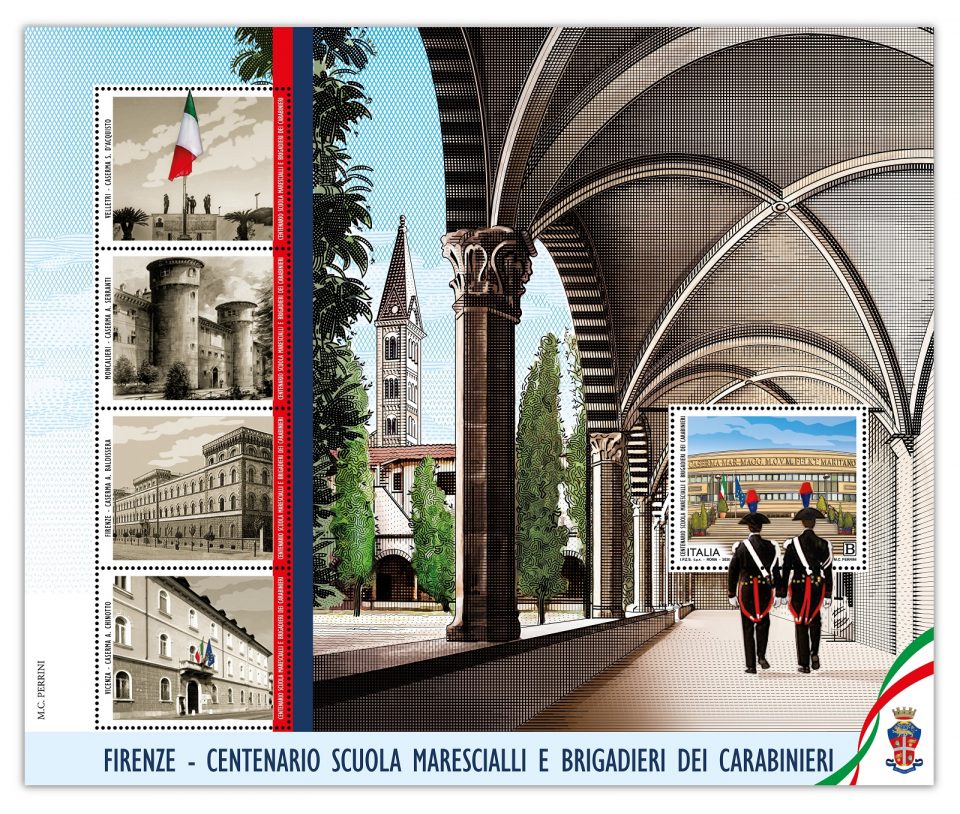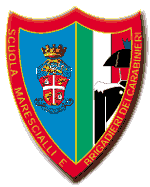POSTE ITALIANE 56^ emissione del 15 ottobre 2020 di un francobollo celebrativo della Scuola Marescialli e Brigadieri dei Carabinieri, nel centesimo anniversario dell’inizio delle attività
POSTE ITALIANE 56^ emissione del 15 ottobre 2020 di un francobollo celebrativo della Scuola Marescialli e Brigadieri dei Carabinieri, nel centesimo anniversario dell’inizio delle attività

Il Ministero dello Sviluppo con le Poste Italiane emette il 15 ottobre 2020 un francobollo celebrativo della Scuola Marescialli e Brigadieri dei Carabinieri, nel centesimo anniversario dell’inizio delle attività, relativo al valore della tariffa B, corrispondente ad €1.10.
- data: 15 ottobre 2020
- dentellatura: 13½ x 13
- stampa: rotocalcografia
- tipo di carta; carta bianca patinata neutra -autoadesiva non fluorescente
- stampato: I.P.Z.S. Roma
- tiratura: 200.000
- dimensioni: 48 x 40 mm
- foglietto: 228 x 190 mm
- contenuto foglio: 45 esemplari
- valore: B = €1.10
- bozzettista: Maria Carmela PERRINI
- num. catalogo francobollo: Michel 4081 YT _______ UNIF ________
- num. catalogo foglietto: Michel______ YT _______ UNIF BF103
- La vignetta: del francobollo: il francobollo, racchiuso in un foglietto, raffigura la nuova Caserma “Felice Maritano” di Firenze che ospita la Scuola Marescialli e Brigadieri dei Carabinieri. Completano il francobollo la leggenda “CENTENARIO SCUOLA MARESCIALLI E BRIGADIERI DEI CARABINIERI” la scritta “ITALIA” e l’indicazione tariffaria “B”. del foglietto: Raffigura due Carabinieri Allievi Marescialli, di spalle, che percorrono il chiostro della basilica di Santa Maria Novella di Firenze, sede della vecchia Caserma dei Carabinieri Goffredo Mameli. Completano il foglietto a sinistra, quattro chiudilettera, delimitati da una bandella di colore rosso e blu, raffiguranti rispettivamente altre quattro Caserme italiane, tre delle quali già sedi della Scuola Marescialli e Brigadieri dei Carabinieri: la Caserma A. Chinotto di Vicenza, la Caserma A. Baldissera di Firenze, la Caserma A. Serranti di Moncalieri, e la Caserma Salvo d’Acquisto di Velletri ove insiste attualmente il 2° Reggimento della Scuola Marescialli e Brigadieri, mentre il 1° Reggimento è dislocato presso la Caserma “Felice Maritano” di Firenze. In basso, a destra, del foglietto è riprodotto, all’interno di una fascia tricolore, lo stemma araldico dei Carabinieri. Completa il foglietto la leggenda “FIRENZE – CENTENARIO SCUOLA MARESCIALLI E BRIGADIERI DEI CARABINIERI”; completano i chiudilettera la leggenda “CENTENARIO SCUOLA MARESCIALLI E BRIGADIERI” e le rispettive leggende “VICENZA – CASERMA A. CHINOTTO” , “FIRENZE – CASERMA A. BALDISSERA” , “MONCALIERI – CASERMA A. SERRANTI” e “VELLETRI – CASERMA S.D’ACQUISTO”
Se sei interessato all’acquisto di questo francobollo lo puoi acquistare al prezzo di € 2.00. Inviandomi una richiesta alla email: protofilia1@gmail.com
La Scuola marescialli e brigadieri dei carabinieri, istituto militare di rango universitario, offre, nel triennio accademico, una preparazione di base dei futuri marescialli dell’Arma. Si configurava su due sedi: una a Velletri ed una a Firenze. Dall’anno 2016 la sede è la nuova caserma “Felice Maritano”, sita in Firenze zona Castello.

Della precedente sede fiorentina facevano parte la caserma “Goffredo Mameli”, con accesso in piazza della Stazione (civico 7) e in via della Scala, nel sito dell’ex monastero della Santissima Concezione e di una parte del complesso di Santa Maria Novella.
L’edificio storico si compone infatti di due parti ben distinte: il nucleo più antico è rappresentato dal chiostro trecentesco, detto Chiostro Grande, appartenente al convento dei padri domenicani di Santa Maria Novella; la struttura più recente integra il monastero della Santissima Concezione, costruito nel tardo Cinquecento.
Storia
Nel 1810 i conventi di Santa Maria Novella e della Santissima Concezione furono soppressi ed adibiti ad uso militare e, con la restaurazione, quest’ultimo divenne educandato femminile. In questa circostanza il restauro e l’adattamento delle strutture viene affidato a Giuseppe Martelli, che realizzò due scale di notevole valore scenografico e l’aula magna. Con l’unità d’Italia, l’edificio ospitò il Ministero dei lavori pubblici, la Corte di cassazione e la direzione del Lotto. A seguito del trasferimento della capitale a Roma le strutture vennero liberate; parte di esse tornarono ai monaci domenicani, mentre il chiostro Grande e gli ambienti ad esso annessi vengono occupati dal collegio militare (1874).
Agli inizi del Novecento parte del convento venne occupato dal disciolto Museo del Risorgimento mentre la porzione su via della Scala fu destinata a liceo.
Il complesso fu adibito a sede della scuola per sottufficiali dei carabinieri e venne istituita con decreto luogotenenziale n. 1314 del 5 ottobre 1916 al fine di “abilitare alla promozione a vicebrigadiere gli appuntati ed i carabinieri”; prese il nome di “Scuola allievi sottufficiali carabinieri” ed entrò in funzione il 5 gennaio 1920. L’apertura di via Santa Caterina da Siena comportò la distruzione del lato ovest del fabbricato, successivamente ricostruito su progetto dell’architetto Aurelio Cetica.
La scuola cambiò nuovamente nome in “Scuola centrale carabinieri reali” con il regio decreto n. 742 del 18 marzo 1928 “in considerazione che la Scuola allievi sottufficiali carabinieri svolge anche corsi di abilitazione per gli ufficiali”. Vennero così istituiti in quella sede i corsi di formazione per gli ufficiali dell’Arma, sino al 1º novembre 1952, data in cui venne istituita la Scuola Ufficiali a Roma.
Nel 1952 la scuola prese il nome di “Scuola sottufficiali carabinieri” con circolare del comando generale dell’Arma n. 870/31 del 1º novembre. L’aumentare delle esigenze di sicurezza del paese, e il relativo ridimensionamento dell’organico, in costante aumento, portarono l’Arma a suddividere l’attività di formazione in due anni, affidando il primo periodo formativo a una nuova sede, mantenendo il secondo anno a Firenze.
La scelta della nuova sede cadde su Moncalieri alle porte di Torino, nella sede del grandioso castello Reale che sovrasta la città, alla fine del secondo conflitto mondiale. Il 15 ottobre 1948, dopo alcuni lavori di ristrutturazione e adeguamento, ebbero inizio i corsi di formazione basica per gli allievi sottufficiali, che furono divisi in tre compagnie allievi inquadrate nel 1º battaglione.
Successivamente il comando generale, decise il trasferimento del 1º battaglione nella nuova sede di moderna costruzione a Velletri; il 1º settembre 1969 il battaglione allievi si trasferì nella caserma intitolata al vicebrigadiere medaglia d’oro al valor militare alla memoria di Salvo d’Acquisto.
Con il decreto legislativo del 12 maggio 1995 n. 198 riguardante il riordino dei ruoli la scuola ha di nuovo cambiato nome in “Scuola marescialli e brigadieri carabinieri”. La modifica è diventata effettiva dal 1º settembre 1996. Al termine dei due anni di formazione infatti il grado assegnato agli allievi non era più quello di vicebrigadiere bensì quello di maresciallo, dato il riordino delle carriere. La scuola, fino al 2016 era articolata su tre reggimenti: 1º reggimento allievi marescialli in Velletri; 2º reggimento allievi marescialli in Firenze; reggimento allievi brigadieri in Vicenza.
Dal 2000 il 1º Reggimento ha assunto la denominazione di 1º Reggimento allievi marescialli e brigadieri a seguito della chiusura del reggimento di Vicenza e la successiva inaugurazione, presso quella sede, del CoESPU, “Centro di eccellenza per le unità di polizia di stabilità i 1º marzo 2005. La sua fanfara è stata istituita nel 1962, anche se si hanno notizie di nuclei di trombettieri al suo interno già nel 1820,
Al termine del periodo formativo biennale gli allievi conseguivano la nomina a maresciallo e la laurea di primo livello in “operatori della sicurezza sociale” presso l’Università di Firenze.
Attualmente la scuola marescialli e brigadieri dei carabinieri si articola su:
- stato maggiore (ufficio personale, ufficio addestramento, ufficio logistico, reparto comando, sezione sanità);
- servizio amministrativo;
- reggimenti allievi marescialli.
A Velletri si svolgevano il primo ed il secondo anno del corso triennale, per la preparazione di base dei futuri marescialli, il corso annuale per marescialli e i corsi di aggiornamento e di qualificazione per allievi vicebrigadieri;
Nella sede di Firenze si svolgeva il terzo anno del corso triennale, per allievi marescialli, durante il quale veniva completato e perfezionato l’insegnamento. Il corso triennale per marescialli, a seguito di convenzione stipulata con l’università degli studi di Roma-Tor Vergata, consentiva il conseguimento della laurea di 1º livello in “Scienze giuridiche della sicurezza”.
Nella sede vengono altresì svolti corsi aperiodici anche per le altre forze armate e corpi di polizia.
POSTE ITALIANE 56th issue of 15 October 2020 of a commemorative stamp of the Carabinieri Marshals and Brigaders School, on the 100th anniversary of the start of activities

The Ministry of Development with the Italian Post Office will issue a stamp celebrating the Carabinieri Marshals and Brigadier School on October 15, 2020, on the hundredth anniversary of the start of activities, relating to the value of the B rate, corresponding to € 1.10.
- date: October 15, 2020
- perforation: 13½ x 13
- printing: rotogravure
- kind of paper; neutral white coated paper – self-adhesive non-fluorescent
- printed: I.P.Z.S. Rome
- circulation: 200,000
- dimensions: 48 x 40 mm
- leaflet: 228 x 190 mm
- sheet content: 45 copies
- value: B = € 1.10
- sketch artist: Maria Carmela PERRINI
- num. stamp catalog: Michel______ YT________ UNIF________
- num. leaflet catalog: Michel________ YT_______ UNIF_______
- The vignette: of the stamp: the stamp, enclosed in a sheet, depicts the new “Felice Maritano” barracks in Florence which houses the Carabinieri Marshals and Brigaders School. The stamp is completed by the legend “CENTENARY SCHOOL MARESCIALLI E BRIGADIERI DEI CARABINIERI”, the wording “ITALY” and the tariff indication “B”. of the sheet: It represents two Carabinieri Allievi Marescialli, from behind, walking through the cloister of the Basilica of Santa Maria Novella in Florence, seat of the old Goffredo Mameli Carabinieri Barracks. The leaflet on the left is completed by four letter closers, delimited by a red and blue strip, respectively representing four other Italian barracks, three of which were already seats of the Marshals and Brigadiers of the Carabinieri School: the A. Chinotto barracks in Vicenza, the A barracks . Baldissera in Florence, the A. Serranti Barracks in Moncalieri, and the Salvo d’Acquisto Barracks in Velletri where the 2nd Regiment of the Marshals and Brigaders School currently stands, while the 1st Regiment is located at the “Felice Maritano” Barracks in Florence. Below, on the right, of the sheet, the heraldic coat of arms of the Carabinieri is reproduced within a tricolor band. The leaflet is completed by the legend “FLORENCE – CENTENARY SCHOOL OF MARESCIALLI AND BRIGADIERI DEI CARABINIERI”; the legend “CENTENARY SCHOOL MARESCIALLI E BRIGADIERI” and the respective legends “VICENZA – CASERMA A. CHINOTTO”, “FLORENCE – Barracks A. BALDISSERA”, “MONCALIERI – Barracks A. SERRANTI” and “VELLETRI – CASERMA S.D complete the letter closers” ‘PURCHASE”
If you are interested in purchasing this stamp, you can buy it for € 2.00. By sending me a request to the email: protofilia1@gmail.com

History
In 1810 the convents of Santa Maria Novella and Santissima Concezione were suppressed and used for military use and, with the restoration, the latter became a female boarding school. On this occasion, the restoration and adaptation of the structures was entrusted to Giuseppe Martelli, who created two staircases of considerable scenic value and the main hall. With the unification of Italy, the building housed the Ministry of Public Works, the Court of Cassation and the management of the Lotto. Following the transfer of the capital to Rome, the structures were freed; part of them returned to the Dominican monks, while the Great Cloister and the rooms attached to it are occupied by the military college (1874).
At the beginning of the twentieth century part of the convent was occupied by the dissolved Museum of the Risorgimento while the portion on Via della Scala was used as a high school.
The complex was used as the seat of the school for non-commissioned officers of the carabinieri and was established by lieutenant decree n. 1314 of 5 October 1916 in order to “enable the appointees and the carabinieri to be promoted to vice brigadier”; it took the name of “Carabinieri NCO Pupils School” and came into operation on January 5, 1920. The opening of Via Santa Caterina da Siena involved the destruction of the west side of the building, which was later rebuilt on a project by the architect Aurelio Cetica.
The school changed its name again to “Scuola centrale carabinieri reale” with royal decree no. 742 of 18 March 1928 “in consideration that the Carabinieri Pupils School also carries out qualification courses for officers”. The training courses for the officers of the weapon were thus established there, until November 1, 1952, the date on which the Officers School was established in Rome.
In 1952 the school took the name of “Carabinieri NCO School” with a circular letter from the general command of the Arma n. 870/31 of November 1st. The increase in the security needs of the country, and the relative downsizing of the staff, constantly increasing, led the weapon to divide the training activity into two years, entrusting the first training period to a new location, keeping the second year in Florence.
The choice of the new headquarters fell on Moncalieri at the gates of Turin, in the seat of the grandiose Royal castle that overlooks the city, at the end of the Second World War. On October 15, 1948, after some renovation and adaptation works, the basic training courses for the non-commissioned officer students began, which were divided into three student companies framed in the 1st battalion.
Subsequently, the general command decided to transfer the 1st battalion to the new modern building in Velletri; on 1 September 1969 the pupils battalion moved to the barracks named after the deputy sergeant gold medal for military valor in memory of Salvo d’Acquisto.
With the legislative decree of 12 May 1995 n. 198 regarding the reorganization of roles, the school has again changed its name to “School of marshals and carabinieri brigadieri”. The change became effective from 1 September 1996. At the end of the two years of training, in fact, the rank assigned to the students was no longer that of deputy sergeant but that of marshal, given the reorganization of careers. The school, until 2016 was divided into three regiments: 1st regiment of marshal students in Velletri; 2nd regiment of marshal students in Florence; regiment of brigadier students in Vicenza.
Since 2000 the 1st Regiment has taken on the name of 1st Regiment of marshals and brigadiers students following the closure of the Vicenza regiment and the subsequent inauguration, at that location, of the CoESPU, “Center of excellence for stability police units on 1 March 2005. Its fanfare was established in 1962, although there are reports of groups of trumpeters inside it as early as 1820. At the end of the two-year training period, the students obtained the appointment as marshal and a first level degree in “social security operators” at the University of Florence.
Currently the school of marshals and brigadiers of the carabinieri is divided into:
• staff (personnel office, training office, logistics office, command department, health section);
• administrative service;
• pupil marshal regiments.
The first and second year of the three-year course were held in Velletri, for the basic preparation of future marshals, the annual course for marshals and refresher and qualification courses for junior deputy sergeants;
The third year of the three-year course was held at the Florence headquarters, for marshal students, during which teaching was completed and perfected. The three-year course for marshals, following an agreement signed with the University of Rome-Tor Vergata, allowed for the achievement of a 1st level degree in “Legal Sciences of Security”.
At the headquarters, aperiodic courses are also held for the other armed forces and police forces.







